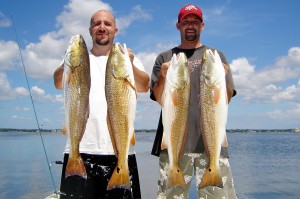With cooler water temperatures settling in along the coastline, larger speckled trout have started to hold in the shallow grassflats. Depths of 1 to 3 feet has been the primary target for anglers wishing to sight cast these hard fighting fish. As the tide floods, trout will move into the skinniest water seeking refuge and warmer water. The lower water column will also funnel baitfish, crabs and other crustaceans into edges and easier ambush spots. Stealth is key to convince these predators to feed on the offerings tossed their way. Use a push pole or trolling motor to work into the flat.
Artificial offerings- The fish that are holding shallow in the early part of the tide are weary of excess noise.Pumpkin Jig Slammr jerkbaits in motor oil or turtlegrass green rigged weedless are working well in low tide conditions, where a lighter entry to the water is needed. On higher water (2-3 feet), soft suspending lures – Mirrolure Paul Browns and Mirrodines – are working well. The key to working these newer plugs is slowing down the retrieve, to allow the sliding action that brings the strike. By throwing artificials, anglers can cover more water as they methodically work across a flat. The use of lighter braided line, 10 pound test, will add more distance on each cast.
Low Water Redfish- On extreme low tides around the stronger moon phases, many shallow flats become exposed and reveal potholes and edges that are prime ambush zones for redfish. The sandy depressions are easier to spot and allow for great sightcasting from a distance. Live shrimp or scented plastics will consistently get bites. The best method is to deadstick the offering in the hole.

